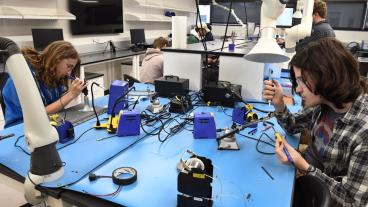A team of Colorado School of Mines researchers has found that the activated carbon filtration systems currently being used to remove highly fluorinated chemicals such as perfluorooctane sulfonate (PFOS) and perfluorooctanoate (PFOA) from drinking water are likely not nearly as effective at removing newly discovered poly- and perfluoroalkyl substances (PFASs).
“It was just over a year ago that the U.S. EPA issued lifetime health advisories for PFOA and PFOS, and while no health advisories have been issued for these related chemicals, they share many of the same characteristics. This study raises important questions about exposure to these compounds, even when carbon filters are being used.” said Chris Higgins, the senior author on the study and an associate professor of civil and environmental engineering at Mines.
The results of their study, which was published June 6, 2017, in Environmental Science and Technology, impacts the current efforts that are underway around the United States to remove PFOA and/or PFOS that were found in the drinking water of communities in and around military bases and airports where a firefighting foam containing the contaminants was used. In response, communities installed, or are currently installing, activated carbon filters to remove these two chemicals.
In their study, Mines researchers found that there are numerous related highly fluorinated chemicals also associated with firefighting foam, and that these newly characterized contaminants are likely to pass through filtration systems designed to remove PFOA and PFOS. “We already know that PFOA and PFOS are linked to a variety of adverse health effects in humans, but health effects data are lacking for most other chemicals in this class.” acknowledged Higgins. The global community is clearly concerned about these other PFASs, as just last week, Norway nominated perfluorohexane sulfonate (PFHxS), one of the PFASs included in the study, to the Stockholm Convention for Persistent Organic Pollutants. In addition to PFHxS itself, at least 20 percent of the newly discovered PFASs that Higgins’ team predicts will break through GAC filters before either PFOS and PFOA are chemical precursors to PFHxS. If ingested, it is likely that they would be transformed to PFHxS in the human body.
The team that contributed to the study, titled “Sorption of Poly- and Perfluoroalkyl substances (PFASs) relevant to Aqueous Film Forming Foam (AFFF)-impacted Groundwater by Biochars and Activated Carbon,” include Xin Xiao, a visiting scholar from Zhejiang University in China, and his PhD advisor, Baoliang Chen. Xin spent a little over one year at Mines working on the project with Higgins and Bridget Ulrich, a Mines PhD graduate now working at the Swiss Federal Institute of Aquatic Science and Technology.
The study’s publication coincides with the release of an ES&T and ES&T Letters Virtual Issue on PFASs put together by Higgins along with other researchers.
Contact:
Megan Hanson, Communications Manager, College of Applied Science and Engineering | 303-384-2358 | mhanson@mines.edu
Mark Ramirez, Managing Editor, Communications and Marketing | 303-273-3088 | ramirez@mines.edu



